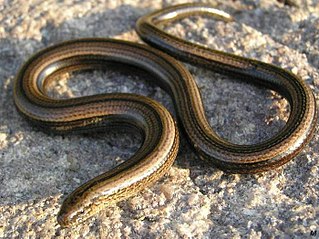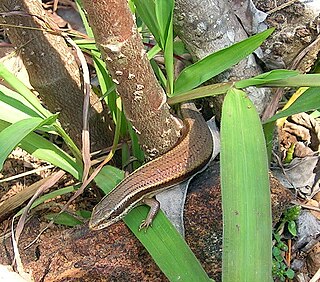
Skinks are lizards belonging to the family Scincidae, a family in the infraorder Scincomorpha. With more than 1,500 described species across 100 different taxonomic genera, the family Scincidae is one of the most diverse families of lizards. Skinks are characterized by their smaller legs in comparison to typical lizards and are found in different habitats except arctic and subarctic regions.
Feylinia boulengeri is a species of skink, a lizard in the family Scincidae. The species is native to Central Africa.

Chalcides is a genus of skinks.
Feylinia is a genus of skinks. It is usually placed in the monotypic subfamily Feylininae.

Scelotes is a genus of small African skinks.
Typhlacontias is a genus of legless, burrowing skinks in the family Scincidae, a genus endemic to Sub-Saharan Africa. Its sister group is the clade consisting of the genera Feylinia and Melanoseps.

Axel Johann Einar Lönnberg was a Swedish zoologist and conservationist. Lönnberg was born in Stockholm. He was head of the Vertebrate Department of the Naturhistoriska Riksmuseet from 1904 to 1933.

Calotes grandisquamis, the large-scaled forest lizard, is an arboreal, diurnal, insectivorous agamid lizard found in the evergreen rainforests of the Western Ghats of India; distributed from Agumbe to Agasthyamalai Hills.

Legless lizard may refer to any of several groups of lizards that have independently lost limbs or reduced them to the point of being of no use in locomotion. It is the common name for the family Pygopodidae. These lizards are often distinguishable from snakes on the basis of one or more of the following characteristics: possessing eyelids, possessing external ear openings, lack of broad belly scales, notched rather than forked tongue, having two more-or-less-equal lungs, and/or having a very long tail.

Trachylepis is a skink genus in the subfamily Mabuyinae found mainly in Africa. Its members were formerly included in the "wastebin taxon" Mabuya, and for some time in Euprepis. As defined today, Trachylepis contains the clade of Afro-Malagasy mabuyas. The genus also contains a species from the Brazilian island of Fernando de Noronha, T. atlantica, and may occur in mainland South America with Trachylepis tschudii and Trachylepis maculata, both poorly known and enigmatic. The ancestors of T. atlantica are believed to have rafted across the Atlantic from Africa during the last 9 million years.

Scincomorpha is an infraorder and clade of lizards including skinks (Scincidae) and their close relatives. These include the living families Cordylidae, Gerrhosauridae, and Xantusiidae, as well as many extinct taxa. Other roughly equivalent terms include the suborder Scinciformata, or the superfamily Scincoidea, though different authors use these terms in a broader or more restricted usage relative to true skinks. They first appear in the fossil record about 170 million years ago, during the Jurassic period. The phylogeny below follows that of Alifanov in 2016.

Lygosominae is the largest subfamily of skinks in the family Scincidae. The subfamily can be divided into a number of genus groups. If the rarely used taxonomic rank of infrafamily is employed, the genus groups would be designated as such, but such a move would require a formal description according to the ICZN standards.

Scincinae is a subfamily of lizards. The subfamily contains 33 genera, and the genera contain a combined total of 284 species, commonly called skinks. The systematics is at times controversial. The group is probably paraphyletic. It is one of three subfamilies of the family Scincidae, the other two being Acontinae and Lygosominae.

The Noronha skink is a species of skink from the island of Fernando de Noronha off northeastern Brazil. It is covered with dark and light spots on the upperparts and is usually about 7 to 10 cm in length. The tail is long and muscular, but breaks off easily. Very common throughout Fernando de Noronha, it is an opportunistic feeder, eating both insects and plant material, including nectar from the Erythrina velutina tree, as well as other material ranging from cookie crumbs to eggs of its own species. Introduced predators such as feral cats prey on it and several parasitic worms infect it.

Pico do Príncipe is a mountain on the island of Príncipe, the smaller of the two inhabited islands of São Tomé and Príncipe. The elevation of the mountain is 947 metres (3,107 ft), making it the highest peak on the island. The island is one of the volcanic swells that make up the Cameroon line of extinct and active volcanoes.
Richard Sternfeld was a German-Jewish herpetologist, who was responsible for describing over forty species of amphibians and reptiles, particularly from Germany's African and Pacific colonies.
The manyscaled feylinia is a species of skink in the family Scincidae. It is endemic to the island of Príncipe in São Tomé and Príncipe.
Feylinia currori, also known commonly as Curror's skink, the western forest feylinia, and the western forest limbless skink, is a species of lizard in the family Scincidae. The species is indigenous to Central Africa.
Feylinia macrolepis is an African lizard in the family Scincidae commonly known as skinks. It is found in Republic of the Congo, and Central African Republic.










